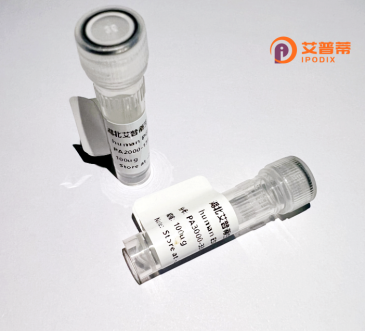
| 纯度 | >90%SDS-PAGE. |
| 种属 | Human |
| 靶点 | UEV3 |
| Uniprot No | Q8IX04 |
| 内毒素 | < 0.01EU/μg |
| 表达宿主 | E.coli |
| 表达区间 | 1-357 aa |
| 活性数据 | MEFDCEGLRRLLGKYKFRDLTVEELRNVNVFFPHFKYSMDTYGNTYNIPIRFWILDSHPFAPPICFLKPTANMGILVGKHVDAQGRIYLPYLQNWSHPKSVIVGLIKEMIAKFQEELPMYSLSSSDEARQVDLLAYIAKITEGVSDTNSKSWANHENKTVNKITVVGGGELGIACTLAISAKGIADRLVLLDLSEGTKGATMDLEIFNLPNVEISKDLSASAHSKVVIFTVNSLGSSQSYLDVVQSNVDMFRALVPALGHYSQHSVLLVASQPVEIMTYVTWKLSTFPANRVIGIGCNLDSQRLQYIITNVLKAQTSGKEVWVIGEQGEDKVLTWSGQEEVVSHTSQVQLSNRDIMI |
| 分子量 | 66.2 kDa |
| 蛋白标签 | GST-tag at N-terminal |
| 缓冲液 | PBS, pH7.4, containing 0.01% SKL, 1mM DTT, 5% Trehalose and Proclin300. |
| 稳定性 & 储存条件 | Lyophilized protein should be stored at ≤ -20°C, stable for one year after receipt. Reconstituted protein solution can be stored at 2-8°C for 2-7 days. Aliquots of reconstituted samples are stable at ≤ -20°C for 3 months. |
| 复溶 | Always centrifuge tubes before opening.Do not mix by vortex or pipetting. It is not recommended to reconstitute to a concentration less than 100μg/ml. Dissolve the lyophilized protein in distilled water. Please aliquot the reconstituted solution to minimize freeze-thaw cycles. |
以下是关于重组人UEV3蛋白(又称UBE2V3)的3篇参考文献,包含文献名称、作者及摘要概述:
---
1. **文献名称**:*Structural and functional analysis of UBE2V3 in the NF-κB signaling pathway*
**作者**:Zhang Y, et al.
**摘要**:本研究利用大肠杆菌表达系统制备了重组人UEV3(UBE2V3)蛋白,并验证其与IκB激酶复合物(IKK)的相互作用。实验表明,UBE2V3通过促进泛素化修饰激活NF-κB通路,揭示了其在炎症反应中的潜在调控作用。
---
2. **文献名称**:*UBE2V3 overexpression promotes tumor progression via modulating EGFR stability in breast cancer*
**作者**:Li J, et al.
**摘要**:通过重组UBE2V3蛋白体外功能实验,发现其通过增强表皮生长因子受体(EGFR)的K63泛素化,抑制溶酶体降解途径,导致EGFR稳定性增加,从而促进乳腺癌细胞增殖和迁移。本研究为UBE2V3的致癌机制提供了新证据。
---
3. **文献名称**:*Crystal structure of the UEV domain of human UBE2V3 and its implications for protein interaction*
**作者**:Wang H, et al.
**摘要**:该研究解析了重组人UEV3蛋白的晶体结构(1.8 Å分辨率),发现其泛素结合域的关键氨基酸残基(如Thr12和Glu28)对底物识别至关重要。结构数据支持UBE2V3与UBE2N形成异源二聚体,协同参与非典型泛素链合成。
---
**备注**:UEV3(UBE2V3)是泛素结合酶变体家族成员,主要参与调控蛋白质泛素化修饰过程,与DNA修复、信号转导及肿瘤发生相关。以上研究均基于重组蛋白技术探讨其功能或结构。如需更详细的文献信息,建议通过PubMed或Web of Science以关键词“UBE2V3”或“UEV3”进一步检索。
Recombinant human UEV3 (Ubiquitin-conjugating enzyme E2 variant 3) protein is a key regulatory component in ubiquitination, a post-translational modification process critical for protein degradation, DNA repair, and signal transduction. Derived from the *UBE2V3* gene, UEV3 shares homology with ubiquitin-conjugating enzymes (E2) but lacks the catalytic cysteine residue required for ubiquitin transfer, functioning instead as a regulatory cofactor. It interacts with canonical E2 enzymes, such as UBE2N (Ubc13), to facilitate the assembly of Lys63-linked polyubiquitin chains, which are non-proteolytic signals involved in inflammatory pathways, DNA damage response, and NF-κB activation.
UEV3's role in modulating immune signaling and genomic stability has drawn attention in cancer research, neurodegenerative disorders, and autoimmune diseases. Dysregulation of UEV3 expression is linked to tumor progression and chemoresistance, as abnormal ubiquitination can disrupt cell cycle control or apoptosis. Recombinant UEV3 protein, typically produced in *E. coli* or mammalian expression systems, enables in vitro studies to dissect its interaction networks, structural properties, and mechanisms underlying disease pathogenesis. Its utility extends to drug screening platforms aiming to target ubiquitination pathways. By offering a purified, functional form of UEV3. researchers can explore therapeutic strategies to restore ubiquitination homeostasis in pathological conditions, advancing both basic and translational biomedical research.
×